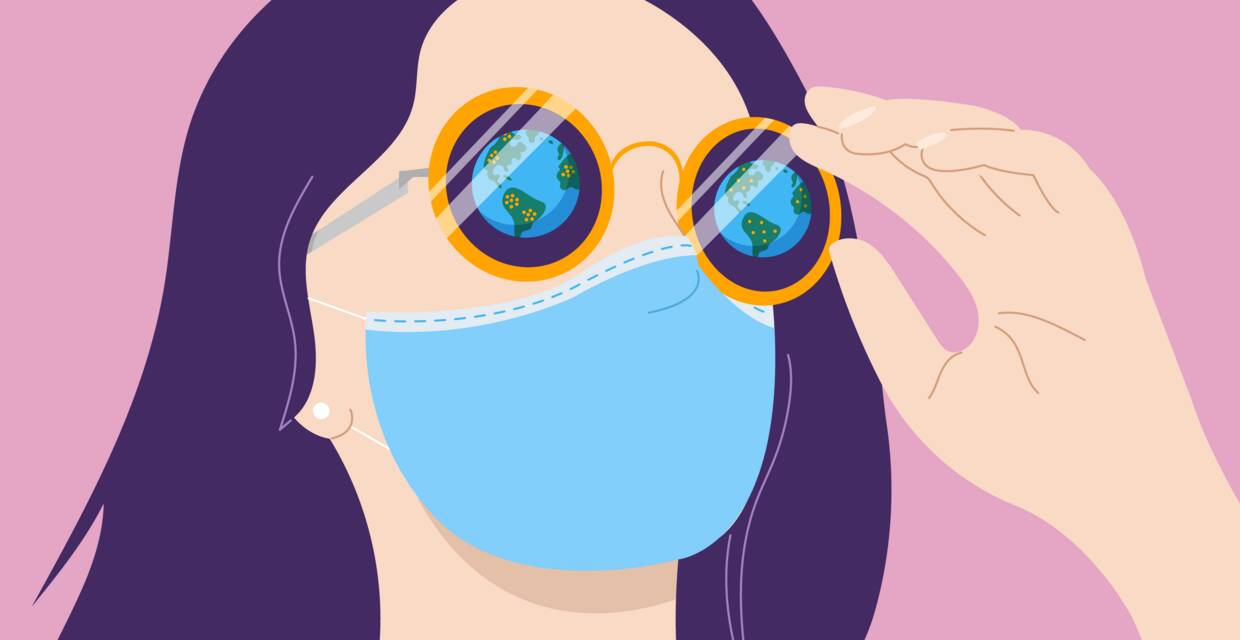Key Points
- The term "endemic" is increasingly used in pandemic discussions, suggesting that COVID-19 will become a regular part of life, similar to the common cold or flu. However, becoming endemic does not mean the end of the virus but rather that it is spreading at a controlled speed and has reached equilibrium.
- The concept of endemicity does not provide information about the severity or case count of infections. Experts cannot guarantee when or if COVID-19 will become endemic.
- Some regions are adopting "endemic strategies" to live alongside the virus. For instance, California emphasizes prevention and swift action when outbreaks occur, focusing on identifying surges or new variants, increasing healthcare workers, and building up testing supplies.
- Personal "endemic strategies" can include proactivity, prevention, and flexibility. This includes maintaining at-home tests, staying updated with case counts and CDC guidelines, and adapting to changing circumstances, such as wearing masks during surges.
- The article emphasizes managing expectations, as the virus is likely to continue in cycles. It encourages maintaining pandemic practices while also allowing oneself to live life and find joy. It also promotes staying proactive about COVID care, such as booking same-day COVID tests.
The word “endemic” has become a trendy talking point in pandemic lingo — the latest of buzzwords that have surfaced during our pandemic chapters of life (from “flatten the curve,” “hot vax summer” and so the list goes on).
We’ve been given lots of changing information over the past two years as pandemic circumstances shift — like how staying home saves lives, why new variants might be able to evade our body’s protections or how COVID could eventually evolve to behave similarly to a common cold or flu. Now in this new chapter of pandemic life, we’re being told that COVID is bound to become “endemic” in the U.S. — even if our society hasn’t gotten there yet.
Our team at Solv will break down what the term “endemic” means and do a bit of myth-busting to explain why some folks are misunderstanding it as a marker of something we’ve all been craving these past two years: normalcy. Then we’ll dive into a broader question: What is life going to be like with COVID in our lives?
Right now, many families may feel like we’re in a moment when life feels almost normal again. Case counts have thankfully dwindled after the Omicron surge, but there are bound to be points when they rise again with new variants. We’ll share some ways that our team is thinking about how to manage our lifestyles, approaches and mentalities during this chapter so we can navigate the pandemic cycles to come.
First, what does endemic mean?
People have been throwing around the term “endemic” quite a bit in popular culture. Some are interpreting this as a benchmark that we’ll reach when the virus is stable, and presume that after this point we can begin to live with COVID like it’s the seasonal flu.
However, reaching endemicity doesn’t mean that COVID will be over like a light switch. It’s a term to describe a disease state. A disease can become an epidemic, pandemic or endemic. Here’s a quick refresher on the first two:
- Epidemic: An unexpected increase in the number of disease cases in a specific geographical area, as defined by Columbia’s Mailman School of Public Health.
- Pandemic: When a disease’s growth is exponential, according to the Mailman School, and it impacts several counties and populations across a wide area. As the WSJ notes, it’s “an epidemic that becomes widespread around the world.”
How do we define endemic? Experts can’t agree on one clear answer, Jacob Stern and Katherine Wu explain in The Atlantic. Though there are multiple definitions, a helpful way we’ve thought about an endemic state is predictability in the average number of people who transmit a disease over a time period.
Let’s take a year, for example. If COVID were to become endemic, every person that catches it might spread it to one other person on average per year, according to The Atlantic.
What information “endemic” does and doesn’t tell us
A useful metaphor to understand endemicity is a bathtub, note Wu and Stern in The Atlantic. Water is flowing in and out of the tub at a steady, consistent pace. The water isn’t suddenly overflowing or draining.
Even if COVID becomes endemic, this status doesn’t tell us much about how severe or mild infections are, or how high or low case counts are. It just means COVID is spreading at a controlled speed and has reached an equilibrium. As Wu and Stern put it: “The water in that tub might be hot or cold; the level it plateaus at can be very high or very low.”
Experts don’t have a guarantee on when COVID will become endemic — or if it ever will, according to The Atlantic. Plus, reaching endemicity — in a geographic area, or population — doesn’t mean our experiences with COVID are over. So how can you continue moving forward with the virus in your life?
“Endemic strategies” for living with COVID
On a large scale, some regions have launched “endemic strategies” to navigate this phase of life, when we exist alongside COVID rather than hiding from the virus outright.
California became the first state to launch such a strategy in February: Rather than mask mandates or shutdown, California governor Gavin Newsom’s “endemic” approach emphasizes prevention and swift action when outbreaks crop up, according to NPR. This means steps like putting resources toward identifying surges or new variants, adding health care workers and building up testing supplies.
Another way to think about the next chapter is the “control” phase, as Katherine Wu writes in The Atlantic.
What could your personal “endemic strategy” look like?
At Solv, we find it helpful to think about proactivity, prevention and changing shades of gray when it comes to controlling the spread of COVID.
- Be proactive: Make sure you have at-home tests handy and supplies to manage symptoms if you test positive. Keep up your pandemic practices, like testing often — and not just during a surge, Katherine Wu writes in The Atlantic.
- Prevention: It can be helpful to stay up to date with case counts in your region or places you’re traveling, read the news and adapt to CDC guidelines as they change. To build immunity, keep up with your booster shots as they become available.
- Shades of gray: When cases are surging, you could consider masking up or adjusting how you socialize for the time being. Remember that this isn’t black-and-white, and your actions don’t have to be forever: you may feel most comfortable masking at a party in May but taking off the mask in June based on what’s going on, and that’s ok. You can adapt as you see fit.
Managing expectations
The bottom line: we’ve lived through many cycles of COVID. The virus is likely to wax and wane again, according to The Atlantic. So from a mental health and planning standpoint, it can be helpful to manage expectations and shift our thinking away from all-or-nothing approaches. There won’t be one finish line to the pandemic where it’s all over, as Calif. Gov. Gavin Newsom put it.
Even so, you don’t have to dust off your best pajama set and mentally prepare for total lockdowns and social isolation! Keep your eye on what’s happening and maintain your practices — but at the same time, give yourself permission to live your life and find joy where you can. Many things can be true at the same time! Striking that balance can be tricky, but figuring that out will be what this next phase of pandemic life is all about.
Keeping up with COVID care in this next chapter
Want to stay proactive about managing your COVID care? To get ahead on testing, Solv can help you find and book same-day COVID tests near you. Meanwhile, Solv Now can connect you with exceptional virtual providers in as little as 15 minutes, 24/7, for only $79 per visit.
Frequently asked questions
What does the term "endemic" mean in relation to COVID-19?
The term "endemic" refers to a disease state where the average number of people who transmit a disease over a time period is predictable. If COVID-19 were to become endemic, every person that catches it might spread it to one other person on average per year.How is an endemic disease different from an epidemic or a pandemic?
An epidemic refers to an unexpected increase in the number of disease cases in a specific geographical area. A pandemic, on the other hand, is when a disease's growth is exponential and impacts several countries and populations across a wide area. An endemic disease is one that is spreading at a controlled speed and has reached an equilibrium.Does reaching endemicity mean that COVID-19 will be over?
No, reaching endemicity does not mean that COVID-19 will be over. It simply means that the disease is spreading at a controlled speed and has reached an equilibrium. The severity or mildness of infections and the high or low case counts are not determined by the disease's endemic status.What is an "endemic strategy" for living with COVID-19?
An "endemic strategy" refers to a plan to coexist with COVID-19 rather than hiding from the virus outright. This could include steps like putting resources toward identifying surges or new variants, adding health care workers, and building up testing supplies.How can individuals prepare for a potential endemic stage of COVID-19?
Individuals can prepare by being proactive, such as having at-home tests handy and supplies to manage symptoms if they test positive. They can also focus on prevention, like staying up to date with case counts in their region or places they're traveling, reading the news, and adapting to CDC guidelines as they change. It's also important to be flexible and adapt behaviors as necessary, such as masking up or adjusting socializing habits when cases are surging.What is the "control" phase in the context of COVID-19?
The "control" phase refers to the next chapter of the pandemic where we aim to control the spread of COVID-19 through proactive measures and prevention strategies. It's about managing the disease in our lives rather than trying to completely eliminate it.How can individuals manage their expectations during the potential endemic stage of COVID-19?
It can be helpful to shift our thinking away from all-or-nothing approaches and understand that there won't be one finish line to the pandemic where it's all over. The virus is likely to wax and wane again, so it's important to maintain practices but also give oneself permission to live life and find joy where one can.What resources are available to help manage COVID-19 care?
Solv can help individuals stay proactive about managing their COVID-19 care by helping them find and book same-day COVID tests near them. They can also connect individuals with exceptional virtual providers in as little as 15 minutes, 24/7, for only $79 per visit.


 LinkedIn
LinkedIn










